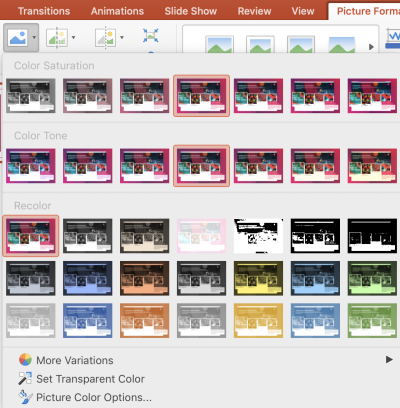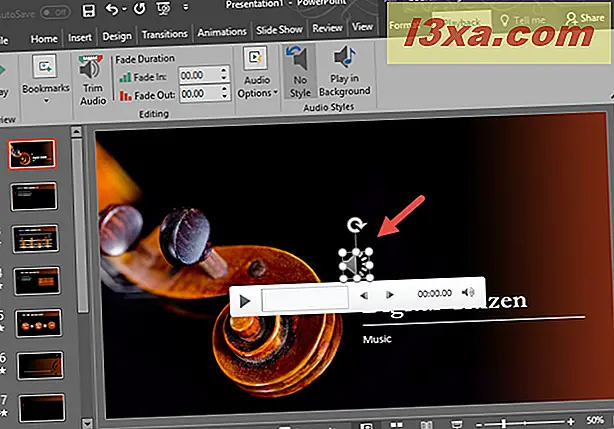- Fade Picture Edges In Powerpoint
- How To Make A Picture Fade In Powerpoint
- Fade Picture Color In Powerpoint
Thanks to the image editing features in PowerPoint 2010 (and also in 2013 which is due to arrive soon), you really don’t need to look elsewhere to handle graphic jobs. Photoshop and industry standard graphic editors can do a lot of heavy lifting, but PowerPoint isn’t a slouch either. Another benefit is that the learning curve in PowerPoint isn’t as steep as in something like Photoshop.
From how to crop images and make them fit perfectly to including a website in a presentation slide, we have seen some neat tricks. Here’s another technique that will add some more pizzazz to your presentations.
The Image Fade Technique
The image fade technique makes for an aesthetic visual as it allows you to blend an image into the background color of the slide. We see it all around us in web pages, advertising, and related media. It is relatively easy to do it in Photoshop. It is easy in PowerPoint too. Follow along…
🌟 Learn With Me & Support My Channel: Tutorial description:With this. How to Fade Picture in PowerPoint PowerPoint application in itself offers the simplest way in which one can fade out pictures for presentation easily. You can select multiple images, align them, and use PowerPoint animation fade in and out to apply the fade effect.
You can blend an image into the background of the slide and use it to highlight the text or use it to bring focus on the key part of an image. Either way, start with a good image. I will leave the selection to you as I start with an image of an apple.

Identify where a fade is required. Typically, I use the image fading technique in two. On the slide, select the box that contains your text. Select the Animations tab, and then select the Add Animation drop-down menu to select an animation, such as Appear, Fade, or Fly In. Select the Animations tab, and then select Animation pane. The Animation Pane.
The image fade technique is a bit like a sleight of hand where you use another invisible object to hide a part of the main image and thus combine them to give the appearance of a fade. In this case the other object will come from the Shapes that PowerPoint gives us under the Insert menu.

From the Insert menu, choose a Shape and use it to overlap the image of the apple (or your own). The size of the shape is important because it decides how the image fade appears. A wider image will make the fade more gradual, while a narrower shape will make the fade seem abrupt. You can choose to overlap your entire image or a part of it. I have gone with a wide rectangle as you can see below.
Fade Picture Edges In Powerpoint
With the shape now on top of the image, right-click on the shape and select Format Shape.
Under the Fill tab, select Gradient fill. Go down to the Gradient stops. By default you have three gradient stops, so remove one of the stops as you only need two here to accomplish the gradual fade effect.
Choose the direction of the gradient fill. For this image, the right direction of the gradient will be from left to right, so I have selected Linear Left.
The next two steps involve setting the color of the gradient to match the background of the slide so it obscures part of the apple, and adjusting the transparency of the gradient so that a fade is created revealing a part of the apple. Here the background of the slide and the image is white, so we go with white for both the stops.
To “flow” the gradient and create the fade effect, you will need to set the transparency of one of the gradient stops (select one of the gradient stops and move the slider for transparency) while keeping the other one opaque. Experiment with the sliders and create the fade effect as per the requirements of the slide. Here’s what I got for my image of the apple.

You have to experiment a bit here because now every image is an apple, and your slide will incorporate your own text and background. But this PowerPoint tutorial is a basic primer on how to create a fade effect without too much of bother.
Image Credit: Free Digital Photos
How To Make A Picture Fade In Powerpoint
The above article may contain affiliate links which help support Guiding Tech. However, it does not affect our editorial integrity. The content remains unbiased and authentic.Read Next
How to Add and Edit Images in Google Forms
Do you want to add
Transparent or faded images (watermarks) are great to use as slide backgrounds in a PowerPoint presentation. They add visual interest, but because they’re faded a bit, they won’t dominate or distract from your slide content.
- In PowerPoint, head to View > Slide Master. Select all the slides that you want to add the watermark to.
- Right-click on the slide and select Format Background > Picture or texture fill. From there, you can pick your image from any number of places: the clipboard, online, or from a file on your local device.
- Next, use the transparency slider. You want to adjust it until you’re happy with the level of transparency of the image.
- If you want this watermark to be universal across all your slides, click the “Apply to all” button.
Fade Picture Color In Powerpoint
Click here to watch this video on YouTube.

